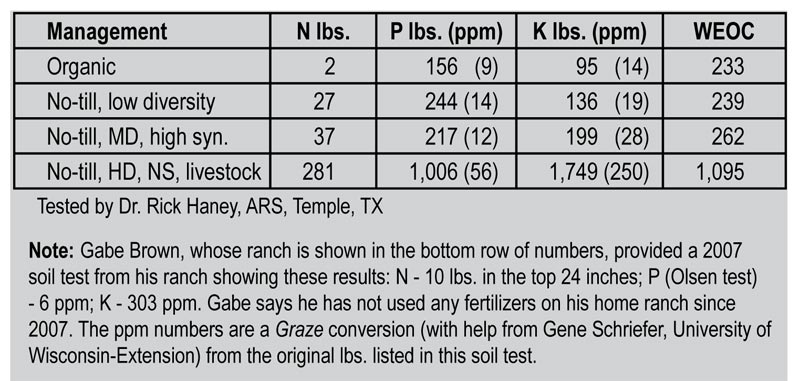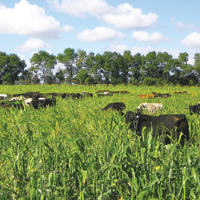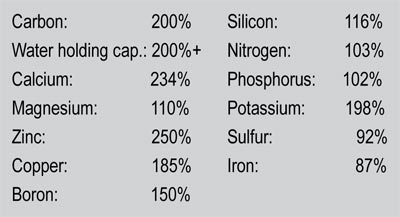This grazing and cover crop system is producing some impressive numbers
By Gabe Brown
Phone calls, emails and even a few old-fashioned letters — all say the same thing. As I travel presenting at conferences and workshops, the statement comes up repeatedly.
If only I had a dollar for the number of times I had people tell me, “Gabe, you just don’t understand that our soils are not like yours.” I have learned to listen patiently (OK, sometimes not so patiently) as these people tell me all the reasons my soils are productive, and theirs are not.
When they finish, I ask them what they imagine their land looked like pre-European settlement. To this I usually receive a puzzled look.
My point is this: How is it that these lands were once healthy, functioning ecosystems? What changed between then and now? Could it be that we are the reason our land is no longer as productive as it once was? Could it be we are the reason that our soils do not function properly?
We get a lot of visitors to our ranch, more than 2,100 last summer alone. I think most come wanting a “silver bullet.” What we show them is simply how to use the principles of nature to their advantage.
I make it a point to show the difference between soils on our ranch and those of nearby operations. All have the same soil types.
The accompanying table shows soil testing results for four operations in my neighborhood. The one titled “Organic” is just that — an organic operation that is very diverse in its cropping system. The operator grows spring wheat, barley, oats, corn, sunflowers, peas, soybeans, dry edible beans and alfalfa. Natural, organic fertilizers are used. No livestock are integrated onto this cropland.

In the “No-till, low diversity” operation, the operator plants only flax and spring wheat in a cropping rotation. Anhydrous ammonia is used, and no livestock are on the land. Crop yields are about average for the area.
The third column is “No-till, medium diversity, high synthetic” fertilizer use. This farm grows corn, barley, sunflowers, spring wheat and soybeans. It has not been tilled in nearly 20 years. Yields are high, but high rates of synthetic fertilizers are used to get those yields, and fungicides, pesticides and amendments are also applied. No livestock are allowed to graze this farm.
Brown’s Ranch is the fourth operation listed. We have not tilled since 1993. We grow corn, spring wheat, barley, oats, peas, cereal rye, winter triticale and hairy vetch as our cash crops. All fields also have a cover crop each year — either before, alongside or after the cash crop.
We have not used synthetic fertilizer since 2007, and we do not use any other purchased fertilizers, compost tea or other soil amendments. We do make a small amount of compost that is used on our gardens.
Livestock are fully integrated onto our cropland. Beef cow/calf pairs, stockers, grass finishers, sheep, pork, laying hens and bees — all are integrated throughout the ranch.
Now look at the results of the soil tests. These tests were analyzed by Dr. Rick Haney of the USDA Agricultural Research Service in Temple, Texas. The first three columns show the pounds of nitrogen, phosphorus and potassium.
The final column is Water Extractable Organic Carbon, listed as parts per million. WEOC is the food that soil biology eats. If your soil is high in WEOC, it has the ability to cycle a lot of nutrients.
Notice how many more nutrients my soils are cycling.
For years I was told that my system would crash because I would run out of phosphorus, potassium and other nutrients. I knew it would not because of how soil functions. I regenerated my soils by simply following the principles of nature.
I find it very interesting that there is very little difference in the results from the first three farms. You see, these farms are not following those principles. They are not treating their farms as ecosystems.
The beautiful thing about those principles are that they will work anywhere in the world where there is production agriculture.
I recently returned from a trip to Australia where I had the good fortune to spend time with Colin Seis on his ranch in New South Wales. Colin has perfected the art of pasture cropping — seeding annuals into perennial grasslands.
In my opinion this is the ultimate system. His very diverse (50 to 60 species) native warm season pastures are grazed with sheep during the growing season. When the warm season species go dormant, Colin no-tills a cool season cash crop or forage crop into them. This cool season annual grows, and is either grazed or harvested for grain. By then the warm season perennials are starting to come out of dormancy, thus providing a living cover.
Colin’s soils have responded in such a way that available nutrient levels have increased significantly over the past 15 years. Those increases are shown in the table below.
Colin’s results, like those from my ranch, are simply the result of following nature’s principles.
Now take a look at the accompanying photos. What you are looking at is sand. But why is the top foot of the soil profile so dark? The answer, of course, is carbon!
But how did that carbon get there? The answer to that is plants. Living plants, to be exact.
Plants take in carbon dioxide from the atmosphere. Through photosynthesis that carbon dioxide is converted into liquid carbon, of which a percentage is secreted into the soil through root exudates. A portion of these exudates feeds soil biology, which in turn feeds the plant. Part of the liquid carbon is converted into carbonic acid. The carbonic acid breaks down rocks, making the elements available.
This is how a healthy soil ecosystem functions. It doesn’t matter if we are talking about cropland or pastureland. It functions the same.
Colin and I treat our operations as the ecosystems they are. We strive to have as much diversity of plants, insects and other animals as possible.
You see, the key to regenerating soils is life! Grow plants! And if you have diversity of plants and animals, you can regenerate your resources!
Gabe Brown grass finishes beef on his family’s ranch near Bismarck, ND.



